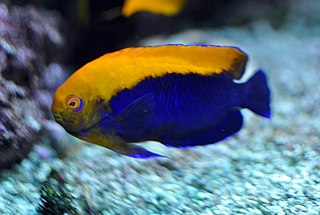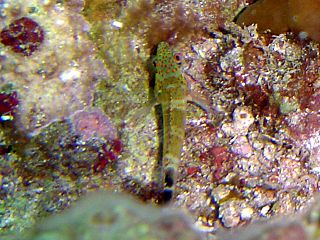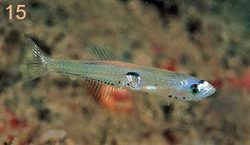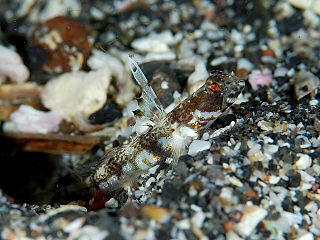
The flameback angelfish, also known as the flameback pygmy angelfish, Brazilian flameback angelfish, Caribbean flameback angelfish or fireball angelfish, is a species of marine ray-finned fish, a marine angelfish belonging to the family Pomacanthidae. It is found in the western Atlantic Ocean.

The French angelfish is a species of marine ray-finned fish, a marine angelfish belonging to the family Pomacanthidae. It occurs in the Western Atlantic Ocean.

Amblyeleotris steinitzi, Steinitz' prawn goby or simply Steinitz' goby, is a species of small fish in the family Gobiidae. It lives in association with an alpheid shrimp and is found from the Red Sea through the Indian Ocean to the western Pacific Ocean.

Elacatinus is a genus of small marine gobies, often known collectively as the neon gobies. Although only one species, E. oceanops, is technically the "neon goby", because of their similar appearance, other members of the genus are generally labeled neon gobies, as well. Except for a single East Pacific species, all reside in warmer parts of the West Atlantic, including the Caribbean and Gulf of Mexico. They are known for engaging in symbiosis with other marine creatures by providing them cleaning service that consists of getting rid of ectoparasites on their bodies. In return, Elacatinus species obtain their primary source of food, ectoparasites.
The striped croaker, also known as the St Lucian corvina, is a species of marine ray-finned fish belonging to the family Sciaenidae, the drums and croakers. This species is found in the western Atlantic Ocean in the Caribbean Sea and Gulf of Mexico.

Pterois mombasae, the African lionfish, deepwater firefish or frillfin turkeyfish, is a species of marine ray-finned fish belonging to the family Scorpaenidae, the scorpionfishes and lionfishes. It is found in the tropical Indian Ocean, typically in soft-bottomed areas of the ocean, often in conjunction with invertebrate growth. It grows to a maximum size of 20 cm, and is of moderate commercial value.

The coral hawkfish, the pixy hawkfish or sharp-headed hawkfish, is a species of marine ray-finned fish, a hawkfish belonging to the family Cirrhitidae. It is native to tropical reefs of the Indian Ocean and the Pacific Ocean. It occasionally is found in the aquarium trade.

The redspotted hawkfish is a species of marine ray-finned fish, a hawkfish belonging to the family Cirrhitidae. It is found at depths from 2 to 46 m on tropical reefs in the Western Atlantic. The Redspotted Hawkfish is also found in the aquarium trade.

Haemulon vittatum, the boga, is an ocean-going species of grunt native to the western Atlantic Ocean. Bogas are also known as the snit in Jamaica, and bonnetmouth in the Bahamas. It was first described by Cuban zoologist Felipe Poey. This species used to be classified as Inermia vittata, but genetic data revealed that it belongs to the genus Haemulon.

The black scorpionfish, also known as the European scorpionfish or small-scaled scorpionfish, is a venomous scorpionfish, common in marine subtropical waters. It is widespread in the Eastern Atlantic Ocean from the British Isles to the Azores and Canary Islands, near the coasts of Morocco, in the Mediterranean Sea and the Black Sea.

Elacatinus evelynae, commonly known as the sharknose goby, Caribbean cleaner goby, or Caribbean cleaning goby, is a species of goby native to the Western Atlantic Ocean from the Bahamas and the Lesser Antilles to the northern coast of South America, as well as the Antilles and western Caribbean.
Elacatinus horsti, the yellowline goby, is a species of goby native to the western Atlantic Ocean and the Caribbean Sea.

Crystallogobius linearis, the crystal goby, is a species of goby native to the Atlantic coasts of Europe and the Mediterranean Sea where it can be found at depths of from 1 to 400 metres. Males of this species grow to a length of 4.7 centimetres (1.9 in) SL while females only reach 3.9 centimetres (1.5 in) SL. This species is the only known member of its genus. The name Crystallogobius comes from the Latin words cristallum, meaning "crystal", and gobius, meaning gudgeon.

Valenciennea helsdingenii is a species of goby from the Indo-Pacific. It is commonly known as the twostripe goby, black-lined sleeper goby, or railway sleeper goby. It can grow up to a length of 25 cm (9.8 in) and is distinguishable by two prominent orange to black lines running longitudinally through its body.
Cable's goby is a species of goby endemic to reefs around the Galápagos Islands. This species grows to a length of 7 centimetres (2.8 in) SL. This species is the only known member of its genus. The specific name honours the United States Government biologist Louella E. Cable (1900-1986), who illustrated this goby for the describer Isaac Ginsburg, and drew his attention to its separated ventral fins.
Elacatinus colini, the Belize sponge goby, is a species of goby native to the Western Central Atlantic Ocean, near Belize and Honduras.
Oxyurichthys petersii, commonly known as Peters' goby, is a species of ray-finned fish, a goby, from the family Oxudercidae. It is native to the Red Sea, and has now colonised the eastern Mediterranean Sea by Lessepsian migration through the Suez Canal.

Tomiyamichthys alleni, Allen's shrimpgoby, is a species of ray-finned fish from the family Gobiidae. It occurs in the western Pacific Ocean where it is commensal with an aplheid shrimp.

Apsilus dentatus, the black snapper, is a species of marine ray-finned fish, a snapper belonging to the family Lutjanidae. It is found in the western Atlantic Ocean.
The blackeye rabbitfish is a species of marine ray-finned fish, a rabbitfish belonging to the family Siganidae. It is found in the Indian Ocean.














